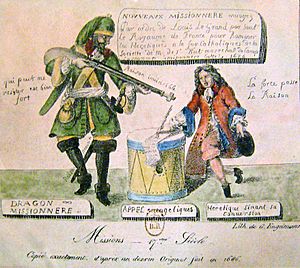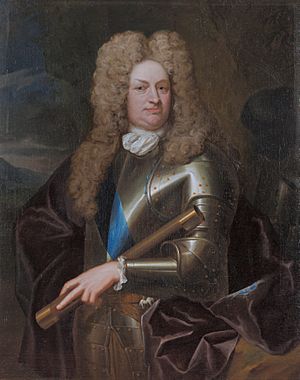Charles Chalmot de Saint-Ruhe facts for kids
Quick facts for kids
Charles Chalmot de Saint-Ruhe
|
|
|---|---|
| Other name(s) | Marquis de Saint Ruth |
| Born | c. 1650 France, probably Poitou (modern Deux-Sèvres) |
| Died | 12 July 1691 (aged 40–41) Attidermot, Aughrim, County Galway, Ireland |
| Buried |
Loughrea
|
| Allegiance | |
| Branch | Cavalry |
| Years of service | c. 1670 – 1691 |
| Rank | Lieutenant-General |
| Battles/wars | Battle of Staffarda; Siege of Athlone; Battle of Aughrim † |
| Spouse(s) | Marie de Cossé |
Charles Chalmot de Saint-Ruhe (around 1650 – 12 July 1691) was a French cavalry officer. He served in the armies of King Louis XIV of France.
Even though he had a long career, Saint-Ruhe is mostly remembered for his short time in Ireland. This was during the Williamite War, when France helped the Jacobite forces of James II. Saint-Ruhe commanded James's Irish Army. He was killed at the Battle of Aughrim. This defeat led to the end of the Jacobite cause in Ireland.
Contents
Who Was Saint-Ruhe?
Saint-Ruhe was from a small noble family called Chalmot. They lived in the Deux-Sèvres region of France. Many members of his family were Protestants. Some even left France after 1685. This was when a law called the revocation of the Edict of Nantes was cancelled. This law had protected Protestants.
Not much is known about Saint-Ruhe's early life. He married Marie de Cossé. She was much older than him, and they had no children. Robert Parker, who fought against Saint-Ruhe, called him "a gallant, brave man, and a good officer." Another writer, Saint-Simon, described him as tall and strong. He was known as a brave soldier.
His Military Career in France
Charles Chalmot started his military career as a lieutenant. He served in the king's special cavalry unit, the Garde du Corps. By 1670, he was a cavalry captain. He quickly rose through the ranks. By 1688, he was a lieutenant-general.
Unlike some of his family, Saint-Ruhe was Catholic. He was part of Louis XIV's dragonnades. This was when soldiers called dragoons stayed in Protestant homes. The goal was to encourage them to convert to Catholicism.
In 1690, Saint-Ruhe fought in the Battle of Staffarda. This was a victory for the French army. His connection to the Irish conflict began in France. He was given command of a group of Irish soldiers. These troops had been sent to France in exchange for French soldiers.
The War in Ireland
King James II and his leader in Ireland, Tyrconnell, asked for more help from France. So, King Louis XIV sent Saint-Ruhe to Ireland. He was to replace James's son, Berwick, as the commander of the Irish Army.
Saint-Ruhe arrived in Limerick, Ireland, on 9 May 1691. He brought weapons, food, and supplies. He also had secret orders to check the situation. This would help King Louis decide if he should send more military aid.
The Williamite forces in Ireland were led by Godert de Ginkel. Ginkel wanted to end the war quickly. He offered the Jacobites good terms if they surrendered. However, Ginkel worried that more French soldiers might arrive. So, he planned to attack as soon as possible. Both sides gathered their armies for the summer campaign.
On 16 June, Ginkel's cavalry moved towards Athlone. This was a Jacobite stronghold. Saint-Ruhe realized Athlone was Ginkel's target. He gathered his troops west of the town. Ginkel attacked Athlone and captured it on 30 June. This was after a difficult siege. Saint-Ruhe could not help the town. His army lost many soldiers who deserted.
Capturing Athlone was a big win for Ginkel. It seemed like the Jacobite army might fall apart. The leaders in Dublin offered good terms to Jacobites who surrendered. They could receive a pardon and get their lands back. They could even join William's army with the same or higher rank.
The Battle of Aughrim
Ginkel did not know where Saint-Ruhe's main army was. He thought he was outnumbered. So, on 10 July, Ginkel slowly moved towards Limerick and Galway.
Saint-Ruhe and Tyrconnell first planned to retreat to Limerick. This would make Ginkel fight for another year. But then, soldiers who had deserted started to rejoin Saint-Ruhe's army. So, Saint-Ruhe changed his plan. He wanted to make up for his defeat at Athlone. He decided to fight a major battle. He told his soldiers that they were defending the Catholic Church in Ireland. He also made promises about what the army would do to their enemies.
Ginkel found Saint-Ruhe's army blocking his way at Aughrim. This was on the morning of 12 July 1691. Saint-Ruhe had chosen a very strong defensive spot. His soldiers were on a hill called Kilcommadan Hill. Marshes protected the sides of the hill. Saint-Ruhe left his army's camp and all their supplies behind. This showed he was determined to win or die.
Both armies started firing cannons around 2 p.m. Ginkel ordered small attacks on the Jacobite lines. Then, a large attack by his foot soldiers began. The Jacobites fought back Ginkel's attacks for several hours. Their counter-attacks caused many losses for Ginkel's army.
Saint-Ruhe was confident he would win. He was planning another attack. But around eight o'clock, he was killed. Saint-Ruhe's death was one of the reasons the Jacobite army fell apart. The battle ended with the Jacobite army running away. Thousands of Jacobite soldiers died.
Some say Saint-Ruhe's body was taken to Loughrea. He was supposedly buried secretly at night in the Carmelite Abbey cemetery. Other stories say he was buried at Kilcommadan. Some even say his body was thrown into a bog or left on the battlefield.
Saint-Ruhe in Local Stories
Many local stories about Saint-Ruhe grew in Galway. One popular story says that a local sheep farmer and his shepherd were angry. Jacobite soldiers had taken their sheep. So, they gave information to an artillery officer named Trench. This information helped him target Saint-Ruhe.
A whitethorn tree grew where Saint-Ruhe supposedly fell. It was called "St Ruth's Bush." People said a light danced around it at night. Visitors would take twigs from it as souvenirs. A plaque near the Beara-Breifne Way still marks the spot. There was also a black stone in the old Kilcommadan graveyard. It was called "St Ruth's Flag" and was said to mark his burial place.




